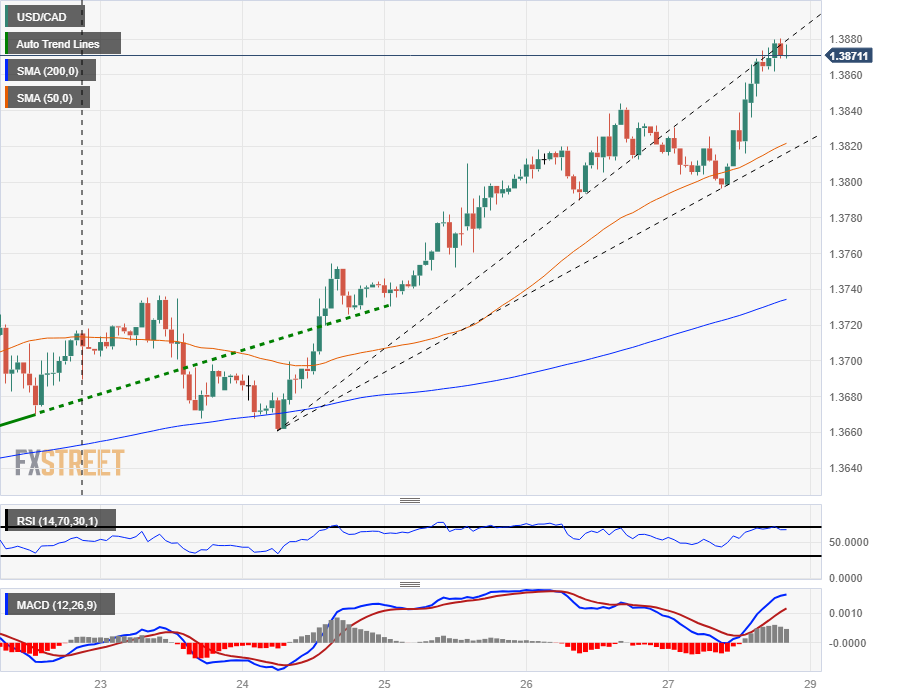- The Canadian Dollar continues to lose ground, down 1% on the week.
- Loonie traders will be looking ahead to Canada GDP figures next Tuesday.
- Crude Oil prices also down for the week, draining support from the CAD.
The Canadian Dollar (CAD) is seeing more declines for Friday and is set to mark a fourth lower day in a row as Loonie traders are having a difficult time finding reasons to bid the CAD.
It’s a quiet market on Friday, but next week brings Canada Gross Domestic Product (GDP) numbers on Tuesday. CAD investors can expect to get jostled frequently by US data all through next week. The Federal Reserve (Fed) makes another rate call on Wednesday and US Non-Farm Payrolls (NFP) are slated for next Friday. The latter coincides with Canadian wages and employment figures.
Daily Digest Market Movers: Canadian Dollar continues backslide, Loonie tumbles against US Dollar
- The CAD is down 1.5% and counting from the week’s highest bids against the USD.
- Friday is set to be day number four of consecutive losses for the Loonie as markets bid the Greenback.
- The BoC has a significant uphill climb before it as inflation risks continue to increase.
- Canadian economic growth is also faltering, limiting the BoC’s policy toolkit.
- Tuesday’s upcoming Canada GDP reading will be important for CAD traders, could see Canada’s technical recession steepen further.
- Despite risks, BoC says they’re willing to raise rates further “if needed”.
- Next week will close out with another US NFP print.
Technical Analysis: USD/CAD hits 12-month high, heading for 1.3900
The Canadian Dollar (CAD) is slumping into new lows for the year against the US Dollar (USD), sending the USD/CAD toward the 1.3900 handle on Friday. The pair is currently trading near 1.3870, and all it will take is one last push to reclaim the price level the pair hasn’t seen since October 2022.
A technical support zone from 1.3600 to 1.3650 stands nearby to bump any downside corrections, with the 50-day Simple Moving Average (SMA) rising into the 1.3600 handle to add further support.
Further beyond that, the 200-day SMA is turning bullish and catching some lift into 1.3500.
The USD/CAD is now up nearly 6% from 2023’s bottom bids of 1.3092.
USD/CAD Hourly Chart

US Dollar price today
The table below shows the percentage change of US Dollar (USD) against listed major currencies today. US Dollar was the strongest against the Canadian Dollar.
| USD | EUR | GBP | CAD | AUD | JPY | NZD | CHF | |
| USD | -0.13% | 0.07% | 0.46% | 0.00% | -0.48% | 0.30% | 0.38% | |
| EUR | 0.15% | 0.21% | 0.60% | 0.14% | -0.34% | 0.44% | 0.29% | |
| GBP | -0.10% | -0.20% | 0.21% | -0.12% | -0.59% | 0.20% | 0.31% | |
| CAD | -0.47% | -0.40% | -0.37% | -0.48% | -0.92% | 0.06% | -0.05% | |
| AUD | 0.02% | -0.10% | 0.09% | 0.47% | -0.46% | 0.32% | 0.43% | |
| JPY | 0.46% | 0.32% | 0.54% | 0.91% | 0.48% | 0.79% | 0.84% | |
| NZD | -0.29% | -0.44% | -0.20% | 0.17% | -0.30% | -0.77% | 0.10% | |
| CHF | -0.38% | -0.30% | -0.32% | 0.10% | -0.43% | -0.70% | -0.04% |
The heat map shows percentage changes of major currencies against each other. The base currency is picked from the left column, while the quote currency is picked from the top row. For example, if you pick the Euro from the left column and move along the horizontal line to the Japanese Yen, the percentage change displayed in the box will represent EUR (base)/JPY (quote).
Canadian Dollar FAQs
What key factors drive the Canadian Dollar?
The key factors driving the Canadian Dollar (CAD) are the level of interest rates set by the Bank of Canada (BoC), the price of Oil, Canada’s largest export, the health of its economy, inflation and the Trade Balance, which is the difference between the value of Canada’s exports versus its imports. Other factors include market sentiment – whether investors are taking on more risky assets (risk-on) or seeking safe-havens (risk-off) – with risk-on being CAD-positive. As its largest trading partner, the health of the US economy is also a key factor influencing the Canadian Dollar.
How do the decisions of the Bank of Canada impact the Canadian Dollar?
The Bank of Canada (BoC) has a significant influence on the Canadian Dollar by setting the level of interest rates that banks can lend to one another. This influences the level of interest rates for everyone. The main goal of the BoC is to maintain inflation at 1-3% by adjusting interest rates up or down. Relatively higher interest rates tend to be positive for the CAD. The Bank of Canada can also use quantitative easing and tightening to influence credit conditions, with the former CAD-negative and the latter CAD-positive.
How does the price of Oil impact the Canadian Dollar?
The price of Oil is a key factor impacting the value of the Canadian Dollar. Petroleum is Canada’s biggest export, so Oil price tends to have an immediate impact on the CAD value. Generally, if Oil price rises CAD also goes up, as aggregate demand for the currency increases. The opposite is the case if the price of Oil falls. Higher Oil prices also tend to result in a greater likelihood of a positive Trade Balance, which is also supportive of the CAD.
How does inflation data impact the value of the Canadian Dollar?
While inflation had always traditionally been thought of as a negative factor for a currency since it lowers the value of money, the opposite has actually been the case in modern times with the relaxation of cross-border capital controls. Higher inflation tends to lead central banks to put up interest rates which attracts more capital inflows from global investors seeking a lucrative place to keep their money. This increases demand for the local currency, which in Canada’s case is the Canadian Dollar.
How does economic data influence the value of the Canadian Dollar?
Macroeconomic data releases gauge the health of the economy and can have an impact on the Canadian Dollar. Indicators such as GDP, Manufacturing and Services PMIs, employment, and consumer sentiment surveys can all influence the direction of the CAD. A strong economy is good for the Canadian Dollar. Not only does it attract more foreign investment but it may encourage the Bank of Canada to put up interest rates, leading to a stronger currency. If economic data is weak, however, the CAD is likely to fall.
Information on these pages contains forward-looking statements that involve risks and uncertainties. Markets and instruments profiled on this page are for informational purposes only and should not in any way come across as a recommendation to buy or sell in these assets. You should do your own thorough research before making any investment decisions. FXStreet does not in any way guarantee that this information is free from mistakes, errors, or material misstatements. It also does not guarantee that this information is of a timely nature. Investing in Open Markets involves a great deal of risk, including the loss of all or a portion of your investment, as well as emotional distress. All risks, losses and costs associated with investing, including total loss of principal, are your responsibility. The views and opinions expressed in this article are those of the authors and do not necessarily reflect the official policy or position of FXStreet nor its advertisers. The author will not be held responsible for information that is found at the end of links posted on this page.
If not otherwise explicitly mentioned in the body of the article, at the time of writing, the author has no position in any stock mentioned in this article and no business relationship with any company mentioned. The author has not received compensation for writing this article, other than from FXStreet.
FXStreet and the author do not provide personalized recommendations. The author makes no representations as to the accuracy, completeness, or suitability of this information. FXStreet and the author will not be liable for any errors, omissions or any losses, injuries or damages arising from this information and its display or use. Errors and omissions excepted.
The author and FXStreet are not registered investment advisors and nothing in this article is intended to be investment advice.
Recommended content
Editors’ Picks

Gold moves to record highs past $3,340
Gold now gathers extra steam and advances beyond the $3,340 mark per troy ounce on Wednesday, hitting all-time highs amid ongoing worries over escalating US-China trade tensions, a weaker US Dollar and lack of news from Powell's speech.

AUD/USD: Upside now refocuses the 200-day SMA
AUD/USD advanced for the sixth consecutive daily advance, picking up extra upside impulse on the back of the continuation of the sell-off in the US Dollar. Next on tap for the Aussie now emerges the yearly peak above 0.6400 prior to the key 200-day SMA.

EUR/USD looks to retest its 2025 highs
EUR/USD reversed two consecutive daily retracements and revisited the key 1.1400 neighbourhood as the selling bias in the Greenback gathered extra pace, always against the backdrop of rising uncertainty surrounding US yields. Chief Powell, in the meantime, delivered a neutral message in his discussion over the economic outlook.

Bitcoin held steady as US reveals China faces up to 245% tariffs
Bitcoin (BTC) witnessed little pressure on Wednesday despite the Chinese government selling off parts of its confiscated cryptocurrency holdings.

Future-proofing portfolios: A playbook for tariff and recession risks
It does seem like we will be talking tariffs for a while. And if tariffs stay — in some shape or form — even after negotiations, we’ll likely be talking about recession too. Higher input costs, persistent inflation, and tighter monetary policy are already weighing on global growth.

The Best brokers to trade EUR/USD
SPONSORED Discover the top brokers for trading EUR/USD in 2025. Our list features brokers with competitive spreads, fast execution, and powerful platforms. Whether you're a beginner or an expert, find the right partner to navigate the dynamic Forex market.



